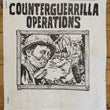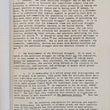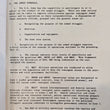


1968 Counterguerrilla Operations - A Special Study to Capitalize on Guerrilla Vulnerabilities
By: Lieut. Col. William Buchanan & Lieut. Col. Robert Hyatt
Date: March, 19, 1968 (dated)
Dimensions: 10.5 x 8.25 inches (26.5 x 21 cm)
A staple bound institutional study of Guerrilla Warfare published during the Vietnam War. The study offers an important modernized account by the United States Army on how to best counter Guerrilla Warfare through proper organization, equipment, tactics, and techniques.
As best described in the introduction to the study, its scope applied worldwide to all phases of insurgency and is concerned with the role of military forces. The study emphasizes those countermeasures which determine success or failure and which have not previously been given appropriate attention. The primary chapters in the study include, "Determination of Vulnerabilities, "Determination of Functions," "The Role of the U.S. Army," and "Findings and Conclusions."
Challenges of Guerrilla Warfare in Vietnam: Tactics, Terrain, and Adversarial Adaptations
The Viet Cong and North Vietnamese Army relied on guerrilla tactics, blending in with the local population, using hit-and-run attacks, and establishing a vast network of tunnels and hidden bases. This made it challenging for the U.S. military to identify and engage the enemy. Additionally, the dense jungles and difficult terrain of Vietnam provided ideal cover for guerrilla warfare. This environment allowed enemy forces to stage ambushes, disappear quickly, navigate through intricate tunnel systems, and capitalize on the widespread use of booby traps All these factors and more made it hard for conventional U.S. forces to effectively combat them.
Condition: This staple-bound study is in B condition, lightly soiled and stained with signs of use. The entire work is securely bound together with the inside pages in near perfect condition.
Inventory #12667
1200 W. 35th Street #425 Chicago, IL 60609 | P: (312) 496 - 3622




